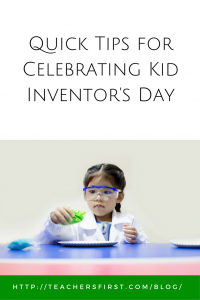“To invent, you need a good imagination and a pile of junk.”
– Thomas Edison
Did you resolve to implement something new into your classroom this year? Or perhaps you want to continue building on something you have already started? If so, you might want to consider celebrating Kid Inventors’ Day on January 17 with your students.
 Kid Inventor’s Day acknowledges previous young inventors and encourages future inventors to develop and expand their creative thoughts. The website for this celebration includes many ideas to celebrate young inventors and contains links to competitions and contests for student innovators. This site also offers tips, quotes, and useful guides for teachers.
Kid Inventor’s Day acknowledges previous young inventors and encourages future inventors to develop and expand their creative thoughts. The website for this celebration includes many ideas to celebrate young inventors and contains links to competitions and contests for student innovators. This site also offers tips, quotes, and useful guides for teachers.
An excellent way to introduce Kid Inventor’s Day to your students is to learn about kids and their inventions. Learn about 13-year-old Alexis and her invention, the Rescue Travois, at the Lemelson Center for the Study of Invention and Innovation. Additional site content shares the successes of many other young inventors across the nation, information on the Invent It! Challenge for kindergarteners, and an in-depth look at the brainstorming process as 5th and 6th graders began and worked through the process of creating an invention.
Find inspiration from award winners of the 2017 National Invention Convention and Entrepreneurship Expo. This site shares links to many videos of kids discussing their inventions. The enthusiasm of the students sharing their stories is definitely worth a visit!
My first thought when learning about Kid Inventors’ Day is the ability to tie this celebration into classroom makerspaces. Perhaps you already are using makerspaces or have considered using them. Makerspaces are increasingly popular in classrooms for many good reasons. ISTE Student Standard #4 encourages students to become Innovative Designers through a variety of technologies and create new, useful or imaginative solutions. As students learn to develop the mindset of makerspaces and innovative thinking, this positive thinking develops confidence, critical thinking skills, and a “can-do” attitude that carries over beyond the initial activity.
This article by John Spencer addresses seven myths keeping teachers from designing Makerspaces and provides real-world thoughts on why these are myths and not facts. A related post on the same site shares additional information on Why Every Classroom Should be a Makerspace. If you are still debating how to do Makerspaces or why you should implement them in your class, these two articles provide useful and encouraging information to get you started.
Looking through the makerspace and invention resources on TeachersFirst, I found several sites with activities and lessons to encourage creativity and project creation for all grade levels:
- This archived Twitter chat from July 2016 includes first-hand experiences and suggestions from teachers on how to create and implement a school Makerspace from scratch.
- Makerspaces.com provides ideas, projects, and tips for all grade levels. Use this site to find tutorials for designing circuits, supply lists to get started, and free printable activities.
- Makershare is another site dedicated to encouraging the Maker Movement. Here you will find projects, missions, and online workshops for both new and experienced makers. Although elementary level teachers and students may find information on this site, older students will find it most useful.
- Makerspace Lesson Plans is for teachers in grades K-6. This site shares lesson plans in a variety of topics including circuitry, coding, and more that are suitable for beginners at a relatively low cost.
- The Renovated Learning blog by Diana Rendina shares ideas from a middle school media specialist/teacher-librarian to help start, grow and rethink learning spaces.
- Makerspace for Education is another website built to empower and provide educators with information and tools to create and maintain makerspace journeys.
Take a look at some of the ideas on the Kid Inventors’ Day website with suggestions on how to celebrate young inventors. I love the idea of an Invention Convention! Use Kid Inventors’ Day to kick off your convention planning, then hold a convention later in the year showcasing student work. Don’t forget to have students record both successes and failures as part of their invention journey to share during the convention.
We would love to hear about your makerspace and Kid Inventors’ Day journeys. Do you have tips to share with other educators? What have you learned to help newbies as they begin to explore makerspaces? Share your thoughts in the comments below.


To learn more about the National Invention Convention and Entrepreneurship Expo (NICEE) winners in 2017 and 2016, go to: http://www.stemie.org/news/. NICEE 2018 will be held at The Henry Ford Museum of American Innovation in Deaborn, Michigan, on June 1st.